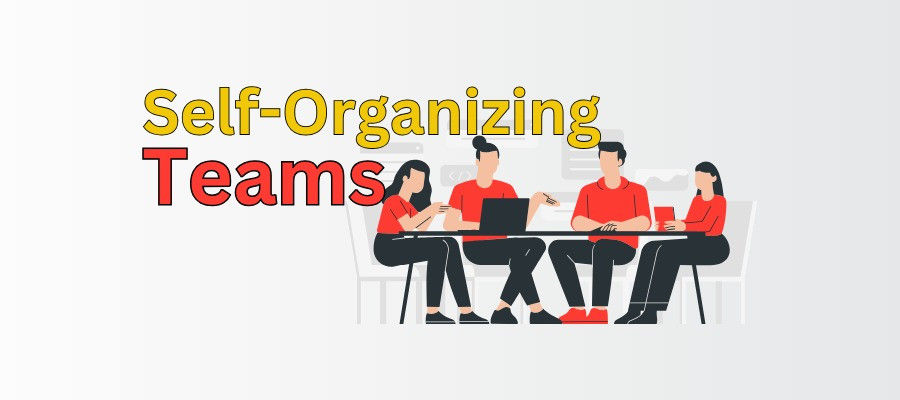Agile Principles #11: Self-Organizing Teams Drive Innovation

Welcome to the 11th installment of our Agile Principles Series! In this exploration, we shine a spotlight on the 11th principle from the Agile Manifesto that states:
“The best architectures, requirements, and designs emerge from self-organizing teams.”
Has your organization already created self-organizing teams? If not, join us as we discuss the top characteristics of self-organization and try to understand how they can contribute to innovative product designs and architectures. So, let’s get started!
Understanding The Characteristics of Self-Organizing Teams:
Self-organizing teams embody Agile methodology with unique characteristics that set them apart. These teams demonstrate:
- Autonomy: Self-organizing teams have the freedom to make decisions independently. It allows them to adapt to changing circumstances quicker.
- Collaboration: Team members actively engage in open communication to share ideas. They collectively share meaningful insights to contribute to the Product Roadmap.
- Responsibility: Each team member takes ownership of their work. They take accountability for completing User Stories or Features depending on the Goal.
- Adaptability: Embracing change is a core trait of self-organizing teams. They are Agile in adjusting their strategies based on feedback and evolving project requirements.
Let’s understand what the self-organizing teams do to carry out their day-to-day activities!
The Main Responsibilities Of Self-Organizing Agile Teams:
- Active Participation in Decision-Making: Self-organizing teams thrive on collectively participating in the Sprint Planning sessions for decision-making. They produce well-rounded outcomes with clear Sprint Goals.
- Dynamic Collaboration: In a self-organizing Scrum team, everyone actively participates in regular discussions about the current work progress through Daily Scrum or Sprint Retrospective. This dynamic collaboration ensures that diverse perspectives are considered to find comprehensive solutions.
- Ownership and Accountability: Self-organizing teams take ownership of their work. Each team member is responsible for individual User Stories and accountable for the Agile Team's overall success.
- Continuous Improvement: A key responsibility of self-organizing teams is continuously improving their Agile Processes and Practices. This commitment to Learning ensures that teams remain adaptive to the changing project dynamics.
How Do Self-organizing Teams Create Emergent Product Designs & Architecture?
Self-organizing teams embrace the concept of emergent design and architecture. Rather than relying on rigid plans, these teams allow the design and architecture to evolve organically as the project progresses. This adaptive approach ensures that the final product is functional and aligned with the ever-changing needs of the stakeholders.
Self-organizing teams set clear Product Goals and keep up the Product Increment happening with Continuous Releases. Plus, the teams can adjust their plan based on real-time feedback and emerging requirements. This responsive decision-making results in designs that are not just technically sound but also highly relevant.
Finally, self-organizing teams become successful in harnessing creativity. As the Scrum Master encourages open communication, the Scrum Team members get a platform to contribute and reflect on their efforts. Thus, these teams tap into a collective creativity beyond individual capabilities. This synergy leads to innovative product designs and architectures.
Can Self-organizing Teams Work in a Cross-Functional Setting?
Absolutely! The cross-functional nature of self-organizing teams is a strength. Want to know why? Let’s find out!
- Diverse Skill Sets: Self-organizing teams often consist of members with diverse skills and expertise. This diversity allows for a comprehensive approach to problem-solving, leveraging the strengths of each team member.
- Flexibility: In a cross-functional setting, self-organizing teams can quickly adapt to changes. The diverse skill sets within the team facilitate a smooth transition when adjusting strategies or addressing evolving requirements.
A cross-functional environment brings the self-organizing teams together, combining their perspectives and backgrounds. This efficient collaboration enhances the team's ability to tackle complex challenges and deliver well-rounded solutions.
Closing Thoughts:
Is the concept of the 11th Agile Principle clear to you now? That’s how self-organizing teams can drive efficient processes with improved productivity. Agile organizations can unlock a powerful innovation engine by empowering teams to take the reins in designing architectures and shaping requirements.
So, why don’t you drive an organizational change by embracing this principle? It’s time to move beyond the constraints of traditional structures and bring self-organization to illuminate the path to Agile Success.
Join us in our next exploration as we unravel the final piece of the Agile Principles puzzle and discover how it encapsulates the essence of Agile wisdom. Until then, continue Learning!
Reference:
https://agilemanifesto.org/principles.html
https://www.scrum.org/resources/blog/how-12-principles-agile-manifesto-work-real-life



